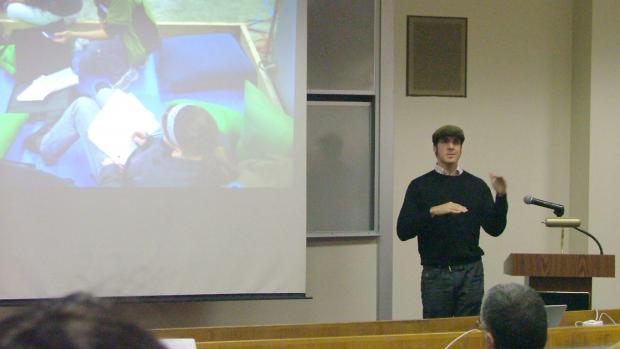d.school Environment Collaborative Co-Directors Give Inaugural Transformative Speakers lecture

Stanford University’s d.school received an incredible gift three years ago (a gorgeous, completely renovated 14,000-square-foot building) with a serious string attached (owing to a law to curb rapid expansion in the Silicon Valley, the d.school would have to move into three increasingly-larger spaces within three years before it could move into the gifted building).
Scott Doorley and Scott Witthoft, co-directors of the Environment Collaborative at the d.school who design the school’s physical spaces, shared lessons learned taking the d.school from a 1,000-square-foot temporary trailer to its current location in a 10,000-square-foot former fluids research lab, during NYU-Poly’s inaugural Transformative Speaker lecture on February 4. The Transformative Speaker Series is a companion piece to the Town Halls and workshops that will encourage faculty, students, and staff involvement in i2e Campus Transformation, NYU-Poly’s plan to rebuild and renovate areas of its Brooklyn campus.
[GALLERY:2872|left]Fittingly, Doorley and Witthoft’s lecture, “Space as a Teacher, Space as a Tool,” took place in the future home of NYU-Poly’s Game Innovation Lab, a multi-functional space for researching games as innovation challenges, conducting lab-style classes, and seminars. [USER:410|profilelink], the lab’s director who holds joint appointments in the Humanities and Social Sciences and Computer Science and Engineering Departments and is herself a Stanford alumna, explained it as a place “to foster conversation and interdisciplinary creativity.”
The idea to create the lab and the grant that will help fund it was announced over a year before NYU-Poly announced plans for i2e Campus Transformation. But according to Provost Dianne Rekow, the lab will be an “example of the way the Campus Transformation project will transform the campus physically and programmatically.”
In addition to their lecture, Doorley and Witthoft led a space planning workshop with faculty and graduate students who will use the Game Innovation Lab.
“What’s best for the students?”
Doorley and Witthoft’s journey, which they liken to the school’s prototyping-heavy curricula, is a case study of sorts for NYU-Poly’s i2e Campus Transformation. Like Campus Transformation, which aims to create classrooms, labs, and common areas that reflect and encourage invention, innovation, and entrepreneurship, the d.school’s transformations centered on the school’s focus on collaboration, design thinking, and creating innovators. Or, more succinctly, the question Doorley said they asked whenever they made a design decision: “What’s best for the students?”
What was best for the students was sometimes counterintuitive. By the third and current iteration of the d.school, Doorley and Witthoft had observed students consistently “hacking” or manipulating their space — from making partitions from white erase boards affixed to rolling garment racks to fashioning special hooks for a dual storage-display system for their class projects. Doorley and Witthoft wanted to push that tendency further. They created a “Brainstormatorium,” a completely white room, from floor to ceiling, to table to chairs. The idea of an all-white room they said, seemed a little cold and institutional to some. But the students loved it. “Every time it gets used, the walls’ erase boards get completely covered,” explained Doorley. “It’s the students’ favorite space.”
Lessons learned, lessons shared
Doorley and Witthoft described other situations where they designed to encourage certain behavior. Not all were as successful as the Brainstormatorium. In their first location, Birch, the 1,000 square-foot trailer, they made a “sandbox” filled with pillows that students would sit in while one of their teammates would stand outside the box to give an informal presentation. Rather than feeling relaxed and open to sharing and listening, the students, who had met only weeks before, felt awkward and uncomfortable sitting so close to each other. It was a valuable lesson for Doorley and Witthoft who studied the result of each design decision — from the type of wood flooring they used in a workspace to the height of a rolling desk — in an effort to refine and improve their next decision.
One of the biggest pieces of hard-earned wisdom Doorley and Witthoft shared was to carefully select the materials in a space to signal the type of work students should do there. For example, they chose a high-end wood floor for a gallery-like area of their new, gifted building where graduate students will be encouraged to showcase their projects. In areas where students will be encouraged to build prototypes, the floor will be far less precious, something like sealed concrete.
The other central lesson, especially for NYU-Poly’s aspirations, sounds obvious: “for transformation to occur, you have to let transformation occur,” in other words, their should be an openness to the range of possibilities, some unexpected, that will come with transforming spaces. Witthoft expanded, “that changes it from people getting a space to people creating a space.”




